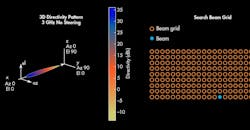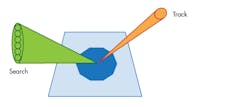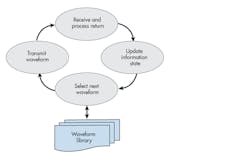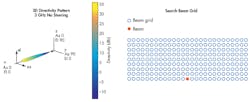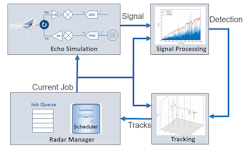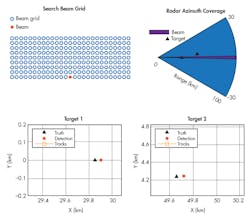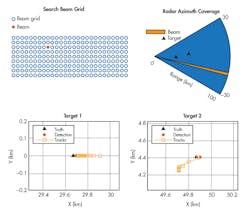Algorithms to Antenna: Closing the Loop in Multifunction Phased-Array Modeling
Multifunction radars perform tasks that historically have required multiple physical radars to accomplish. For example, scanning radars were dedicated to the task of searching for targets, while tracking radars were developed to track targets. The trend for systems now is to encompass applications beyond radar, including communications and electronic warfare (EW). Even if we look just at the radar component of a multifunction phased-array system, search and track tasks represent a subset of the work that needs to be done.
The challenge is that these types of multifunction systems are much more complex to develop. Scheduling multiple tasks is a resource-management challenge. What was once implemented with a fixed priority list has evolved to much more sophisticated resource management.
In our past blogs, we have looked at detailed aspects of radar and communications systems. Here, we expand to system models that support closed-loop simulation. This involves techniques in which the detections generated from signal-level simulation are used to drive the waveforms, frequency, pulse repetition frequency (PRF), and tasks that need to be scheduled in subsequent processing intervals.
To “close the loop” in a model, you can provide detections to a multitarget tracker. The tracker can provide information to a resource manager and waveform scheduler, which in turn drives the next simulation parameters. This is valuable if you are developing the resource manager, but it can also be valuable when building a subsystem and want to see how your design impacts performance that’s further “downstream.” For example, you could evaluate how a change in the antenna design impacts the tracking targets off the radar boresight.
Below, we describe a simple example to show the concept of a closed-loop simulation.
Search and Track Radar
Consider a multifunction phased-array radar that performs both scanning (searching) and tracking tasks. Based on the detections and tracks obtained from the current processing interval, the radar decides what to do next to ensure that targets of interest are tracked and that the desired airspace is searched. Figure 1 shows a notional view of this type of system.
1. This illustration represents a notional multifunction radar performing search and track.
We model an S-band radar with a detection range between 2 and 100 km. The radar includes a phased array that’s electronically scanned. The antenna array is a 50-×-50 rectangular array with elements separated by a half wavelength. With this, we can achieve a half-power beam width of approximately two degrees.
The multifunction radar applies a sequence of operations (matched filtering, time-varying gain, monopulse, and detection) to the received signal to generate range and angle measurements of the detected targets. Figure 2 shows how a waveform library is managed in this type of system. In our example, the library includes search and track waveforms. However, in an actual system, this would be a much larger number.
2. A waveform library is used for dynamic scheduling.
Figure 3 shows the narrow beam formed by the large array as well as a search grid that the beam is steered in. In this example, the radar scans a space from −30 to +30 degrees in azimuth and 0 to +20 degrees in elevation.
3. Shown are the focused radar beam pattern (left) and corresponding search grid pattern (right).
Closing the Loop
Two targets are present in the radar field of view. One target is moving away from the radar starting at a distance of 50 km. The other target is approaching the radar and is 30 km away.
Detections are fed into a multiobject tracker, which maintains a list of tracks and estimates target states in the area of interest. Search beams are transmitted one at a time sequentially until the entire search area is covered. Once the entire search area is covered, the radar repeats the search sequence.
4. This is the simplified simulation loop for multifunction radar (top) and a block diagram of the system (bottom).
For each dwell, the radar looks at all tasks that are due for execution and picks the one that has the highest priority. Consequently, jobs that get postponed increase in priority and are more likely to be executed in the next dwell. Figure 4 shows the simplified inner loop for the simulation along with the data flow of what’s occurring in the model.
The simulation starts with the radar resource manager, which provides an initial search job. Based on this job, the radar transmits the waveform, simulates the echo, and applies signal processing to generate the detection. The detection is processed by a tracker. Then tracks are sent to the radar manager. Based on the tracks and the knowledge about the scene, the radar manager schedules new track jobs and picks the job for the next dwell.
In the top two plots of Figure 5, the search grid is shown with a corresponding bird’s-eye view of the coverage area. The bottom two plots show the ground truth (triangle) and the detections (circle) for the two targets.
5. Here’s the tracking view in our example.
This process repeats for every detected target until the revisit time, at which point the multifunction radar stops the search sequence and performs the track task again.
Figure 6 depicts the same scenario after the targets have been detected and tracks have been initiated. The plot on the left shows the true locations (triangle), detections (circle), and tracks (square) of the two targets. The plot on the right of Figure 6 shows the resource distribution between the search and track tasks as a percentage of time.
6. Tracking summary (left) and resource management allocation (right) are depicted.
While using one multifunction radar to perform multiple tasks has its advantages, it also has a higher cost and more sophisticated logic. In general, a radar has finite resources to spend on its tasks. If resources are used to track tasks, then those resources are not available to search tasks until the tracking tasks are finished.
Due to this resource allocation, resource management thus becomes a critical component when using a multifunction radar. At the beginning of the simulation, all resources are spent on search. Once the targets are detected, the radar resources get split between search and track. Once the second target gets farther away, more resources are freed up for search. The track load increases briefly when the time arrives to track the second target again.
Summary
This example introduces the concept of resource management and task scheduling in a multifunctional phased-array radar system. It shows that, with the resource-management component, the radar acts as a closed-loop system. Although the multifunction radar in this example deals only with search and track tasks, the concept can be extended to more realistic situations in which other functions, such as self-check and communication, are also involved. With a system model like this in place, all disciplines, including RF and antenna, can assess design impacts before the system design is complete.
To learn more about the topics covered in this blog, see the links below or email me at [email protected].
- Search and Track Scheduling for Multifunction Phased Array Radar (example): Learn how to simulate a multifunction phased-array radar system.
- Waveform Scheduling Based on Target Detection (example): Learn how to model a radar that changes its waveform based on the radar detection.
- PRF Agility Based on Target Detection (example): Learn how to model a radar that changes its pulse repetition frequency (PRF) based on the radar detection.
See additional 5G, radar, and EW resources, including those referenced in previous blog posts.
About the Author
Rick Gentile
Product Manager, Phased Array System Toolbox and Signal Processing Toolbox
Rick Gentile is the product manager for Phased Array System Toolbox and Signal Processing Toolbox at MathWorks. Prior to joining MathWorks, Rick was a radar systems engineer at MITRE and MIT Lincoln Laboratory, where he worked on the development of several large radar systems. Rick also was a DSP applications engineer at Analog Devices, where he led embedded processor and system level architecture definitions for high performance signal processing systems used in a wide range of applications.
He received a BS in electrical and computer engineering from the University of Massachusetts, Amherst, and an MS in electrical and computer engineering from Northeastern University, where his focus areas of study included microwave engineering, communications, and signal processing.
Honglei Chen
Principal Engineer
Honglei Chen is a principal engineer at MathWorks where he leads the development of phased-array system simulation. He received his Bachelor of Science from Beijing Institute of Technology and his MS and PhD, both in electrical engineering, from the University of Massachusetts Dartmouth.
